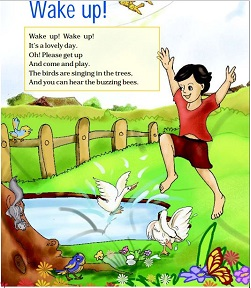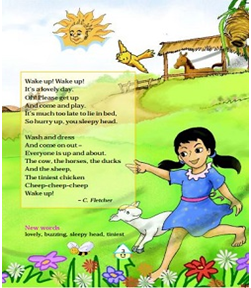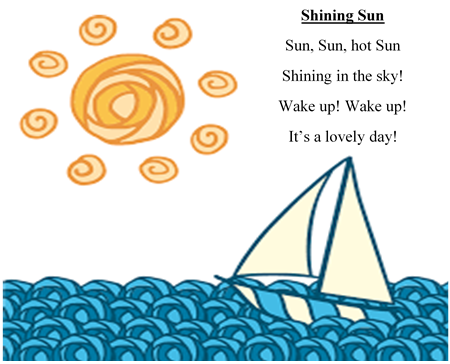Singing songs and poems always create a joyful environment in language classrooms. Students become more involved in the activity when they are able to independently produce songs and poems by themselves. Let us find out how we can facilitate this amongst students using Discourse Oriented Pedagogy.
Naming Words:


This picture is from the NCERT text book of Class 4, Unit 1 (poem)
|
duck, flower, cock, sun, boy, girl, sheep, horse, pond, birds |
The teacher shows a picture chart and asks the students to identify the names of animals and objects in the picture. The teacher writes all of these responses on the board. Students are asked to point to the picture chart and identify these objects in it. They are then asked to point out to the words on the board and read it aloud to the class. Once they have read aloud, students copy the words to their note book.
Describing words: Next, the teacher frames an example for describing the object/thing/person, that the student has identified. E.g. a small duck. Similarly, the teacher encourages students to describe the naming words that they have identified, in the picture. They might come up with responses like these:
|
beautiful flower, hot sun, happy boy, blue girl, tall horse, red cock, yellow birds, small pond, white sheep |
Students should then be asked to read the describing words in groups. The teacher should make sure that each of the students read aloud these words, individually. They are then asked to copy this to their note book, once again.
Action words:
Using the person/object/animal that they have identified, the teacher can then ask students to answer questions related to ‘what’. For instance, in what activity is the object/animal/person involved in? (Example, ‘What is the bird doing?’) Students may answer: ‘bird singing’. Further. they might come up with responses like these:
|
duck flying, boy jumping, sun shining, a girl dancing, bee buzzing, horse standing, cock calling, birds walking, birds sitting, squirrel climbing |
Creating Poem:
The teacher can demonstrate this activity by first choosing a naming word from the students’ responses to write a poem. After eliciting response on ‘what’ the object is doing (while writing the action word), the teacher can then ask, ‘where’ it is, in the picture.
This way, the teacher contributes with two more lines to the first stanza of the poem, as in Figure.1. Teacher can also co-creates a poem similar to the introduced structure, with the whole class, as in Figure.2.



Creating poem in groups
Using the activity demonstrated by the teacher, students can create songs in groups. They can use the same structure and replace necessary words. They could use the naming words, describing words and action words, identified earlier to create this song. e.g: Figure.3.
Each of the student groups could then sing the song to the whole class. The teacher can ask students to enact the song, as they do. Performances of each of the groups can be compiled together and perfected to form a group choreography.
Individual Poem Writing:
The teacher can show another (different) picture on the same theme (morning scene in a village life) and ask students to come up with their own four-line poem using the same structure which the teacher has introduced in the class. This can be completed as home work.
For pictures refer: https://www.pinterest. com/pin/425590233514319993/
Follow-up Activities
Creating a poster After students have come up with their own four-line poem, the teacher can ask each of them to sing their poems aloud in class. Later, the teacher can distribute a sheet of white paper to the children and ask them to write their poem in it and also draw a picture related to it. The teacher can show 3 to 4 sample poem posters with different layouts, to help children. The final output of the children can be displayed in the classroom.
A sample poster is given below:

Term: Term 1
- Log in or register to post comments